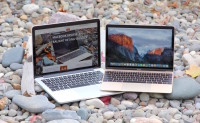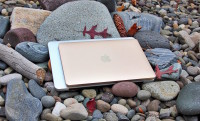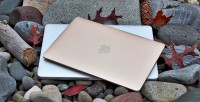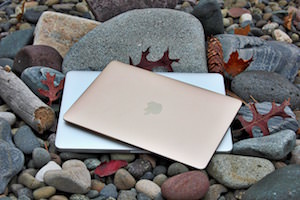Choosing the best MacBook can be hard, but if you consider the core features you value most, the MacBook vs MacBook Pro choice gets easier. When it comes to two of Apple’s most affordable Retina-based MacBooks, the 12-inch MacBook and the newly updated 13-inch MacBook Pro, my key recommendation leans toward a core question: Which do you value more — extreme ultralight portability or overall computing performance?
Quick answer: The MacBook Pro offers a bigger screen, a more powerful processor, an extra port, and weighs just one pound more, making the 13-inch MacBook Pro the best all-around MacBook for both portability and value.
Still, that doesn’t exactly count the 12-inch MacBook out of the running. Let’s take a closer look.
MacBook vs MacBook Pro: Battle of the Retina MacBooks
If you’re reading this, you’ve probably already narrowed down your MacBook vs MacBook Pro choice down to an Apple laptop that has a super-sharp Retina display. The MacBook Air, which is a solid MacBook, does not have a Retina display — I only mention the MacBook Air in case you were unaware of it. In addition, Apple has started to drop the “with Retina display” descriptor. The MacBook is just the “MacBook” while the 13-inch MacBook Pro is now just the “13-inch MacBook Pro.”
Either way, your MacBook Pro decision has a wrinkle: The 13-inch MacBook Pro with Touch Bar.
So let’s tackle this question first: Is the 13-inch MacBook Pro with Touch Bar and Touch ID worth the extra $300 price premium over the 13-inch MacBook Pro? Yes and no. In my opinion, after using a 15-inch MacBook Pro with Touch Bar for months, the answer is no, the Touch Bar with Touch ID is not worth the extra price. The Touch Bar is fine and it works OK, but there is no real need for me to use any high-end application-specific controls. Frankly, I rarely use it for anything interesting at all, and I hear that a good many other MacBook owners rarely use it. On the other hand, the Touch ID button lets you log in with your fingerprint. It works quickly and easily enough. But again, I would have preferred to spend $300 on other Apple or tech-related loot.
But that’s not the whole story because Apple never makes decisions easy. The 13-inch MacBook Pro with Touch Bar also has a slightly faster processor, slightly faster memory, slightly faster graphics, and four Thunderbolt 3 ports versus two Thunderbolt 3 ports. It all adds up to just a tiny performance and usability boost — hardly noticeable for anyone who primarily surfs the web, emails, stores photos, backs up iPhones, and runs office-type applications.
Still, if a little extra performance boost and the Touch Bar/Touch ID catches your attention, the decision is pretty much already made — no need to convince you of anything else because the 13-inch MacBook Pro with Touch Bar is an excellent Mac (even if it seems a bit overpriced).

The MacBook vs MacBook Pro recommendation gets easier when you know which you value most — portability or power?
Moving on. The 12-inch MacBook starts at around $1,299 while the 13-inch MacBook Pro goes for $1,499. So the pricing is in the same ball park.
The MacBook uses a 12-inch, 2304-by-1440 resolution display while the MacBook Pro uses a 13-inch, 2560-by-1600 display. What you need to know here is that the 13-inch has a slightly larger display area, which is handy if you find yourself switching between applications a lot or editing photos.
Ultralight Wonder vs Better Processing Power
The MacBook is super thin and super light — it weighs just 2.03 pounds and is .52 inches thick at its thickest point. It’s hard to describe how portable and light this thing is, so trust me: The new MacBook won’t bother you when you slip it into a backpack or bag.
The 13-inch MacBook Pro isn’t exactly bad itself — it weighs 3.02 pounds and is .59 inches thick. It doesn’t seem particularly heavy . . . until you hold it next to the MacBook. The MacBook is definitely lighter, but will the difference matter in your backpack? Only if you really care about extreme portability.
Let’s say you do want ultralight. Will the MacBook’s processing power hold up to your needs? Probably. It starts with a 1.1 GHz dual-core Intel Core m3 processor. Compared to the MacBook Pro competition, it’s a lightweight, but it is good for web browsing, working with standard office apps, email, and some light photo editing. The screen is fantastic, sharp, and while it’s small, the rich Retina screen is surprisingly usable.
The new 13-inch MacBook Pro, on the other hand, starts with a 2.0 GHz dual-core Intel Core i5 processor, plus it has a faster SSD drive. The memory is the same in both MacBooks.
Two major takeaways here: First, you’re more likely to feel good about your computing performance in 3-5 years if you choose the 13-inch MacBook Pro right now. In three years, I would not be surprised if you feel as if you’ve outgrown the MacBook. If longevity is important to you, error toward the faster processor found in the MacBook Pro.
What about the fan?
The absolutely silent 12-inch MacBook does not have a processor that needs a fan to cool it. The 13-inch MacBook Pro does have a fan, but the fan in the new 13-inch MacBook Pro is surprisingly quiet and it doesn’t seem to spin up as much as in previous generations. It’s just not much of a decision factor anymore.
One Port vs Two-to-Four Ports

One of the reasons the 12-inch MacBook can be so thin is that it only has just one multi-purpose port.
The 12″ MacBook has only one port — a USB-C port that is also a charging port. USB-C is a new standard that can handle all sorts of communication for a variety of peripherals like storage or external monitors. It’s cool, but the MacBook has just one port, which means there is a good chance that you’ll need an adapter with more ports if you want to use your MacBook on a typical desktop to directly attach to an external monitor, a backup drive, or a printer. Of course, many printers are now WiFi enabled, and you can even transfer your photos from your iPhone to a Mac wirelessly, too — so this feature (or limitation) might not bother you.
The 13-inch MacBook Pro has two newer USB-C Thunderbolt 3 ports, which for most users means you can plug your MacBook Pro in to charge while you connect it to an external monitor, storage, printer, or other peripheral. Two ports isn’t a deal breaker, it just makes connectivity easier for most people.
Force Touch Trackpads and the Keyboards
Both of these MacBooks have Apple’s new Force Touch trackpad, which can sense the pressure of your touch and use vibration to make it feel as if you’re moving it to create a click. The track pads are surprisingly good. No major issues here. So what about the keyboards then?
The 12-inch MacBook has a full-size first-generation butterfly-mechanism keyboard. It has bigger keys than previous generation keyboards. It’s very stable. Any downsides? The key travel is minimal — as a guy who spends a lot of time typing, I hated the MacBook keyboard. The keys just didn’t have enough travel.
The new 13-inch MacBook Pro has a newer version of Apple’s new keyboard — and it’s excellent. I had my doubts going into it, but it turns out, it’s very very good. It has far less travel than previous generation MacBook Pro keyboards, but it’s stable and has a bit more travel than what you get in the MacBook. I wouldn’t mind just a half millimeter or so of more travel, but after using the new keyboard for months, I’m very pleased.
If you have keyboard concerns, error toward the 13-inch MacBook Pro.
Battery Power
With either MacBook, you’ll get a full-day of usage out of it. The MacBook, as a consequence of being so small, gets up to about 10 hours of wireless web usage while the larger (and more battery hungry) MacBook Pro manages to get 10 hours of wireless web. Obviously it’s packing a bigger battery, which also adds to its overall weight.
Either way, Apple’s battery tech is great in its laptops, so there’s not much to worry about in the MacBook vs MacBook Pro battery battle here.
External Displays
If you want to power a big external display, up to 4K (3840-by-2160), the MacBook will power one in addition to is built-in screen. The MacBook Pro will drive two 4K displays as well as its built-in screen at 60Hz (this is good). It will also power a full 5K display (5120-by-2880) at 60Hz. For most people who don’t have two external monitors, this isn’t a big deal either way, but if you plan to do more intensive work on your Mac, the MacBook Pro wins the MacBook vs MacBook Pro external display decision factor.
256GB of Storage
Both of these MacBooks ship with 8GB of memory, which is plenty for the vast majority of consumers. If you plan to mess around with video or heavier photo editing, you can configure the 13″ MacBook Pro with up to 16GB of memory. (You can’t configure the MacBook with extra memory.)
As for storage, they also both ship with 256GB of fast storage. The MacBook has faster storage, but it’s not a huge decision-making factor. Apple’s previous generation 13-inch MacBook Pro with Retina display is still available, but it only ships with a paltry 128GB of storage. The only upside to getting the older generation MacBook Pro is that you also get the old USB ports. It’s still a great MacBook Pro, but I no longer recommend choosing it unless someone is truly adverse to using USB-C adapters. (Personally, I thought USB-C would be a major annoyance, but now it’s just an occasional minor inconvenience.)
MacBook vs. MacBook Pro Recommendations
Most consumers can’t go wrong with either the 12-inch MacBook or the new 13-inch MacBook Pro (Late 2016). They both have super-sharp displays, and while the 13-incher is better, most people won’t notice. The key differences come back to an extremely light and tidy form factor vs a more full-sized overall package that can hold a more powerful processor. The MacBook wins in the backpack and in frequent travel situations while the MacBook Pro gets the nod for being faster and more powerful. Overall, they can still do essentially the same things. The differences tend to arise as you attempt to do more serious work with a processor. For example, while you can edit a long video on a MacBook, you will enjoy the experience more on a new MacBook Pro.
The MacBook vs MacBook Pro decision comes down to this:
- Choose the 12-inch MacBook with Retina display if you love the ultra-light form factor or must have a Gold or Rose Gold colored MacBook. I hate to admit it, but the Gold looks great, and while the MacBook isn’t right for my needs, oh baby, it’s still a drool-worthy machine because it’s just so freaking tidy.
- Choose the new 13-inch MacBook Pro if you favor better performance, want to squeak a couple more years of enjoyment out of your MacBook, and want to the better keyboard. (If you have the budget, choose the 13-inch MacBook Pro with Touch Bar for the better processor and Touch ID.)
- Choose the older-generation 13-inch MacBook Pro with Retina display if you want better performance and must have the older set of ports and older keyboard style.
All-in-all, Apple’s new 13-inch MacBook Pro — without the Touch Bar and Touch ID — is the Mac that I recommend to most people, most often. It has a near-perfect blend of performance and portability, and it’s just an excellent machine overall.
Check Prices, Tax, and Shipping Options:
- 12-inch MacBook . . . at Amazon . . . at B&H
- 13-inch MacBook Pro . . . at B&H
- 13-inch MacBook Pro with Touch Bar. . . at Amazon . . . or at B&H









